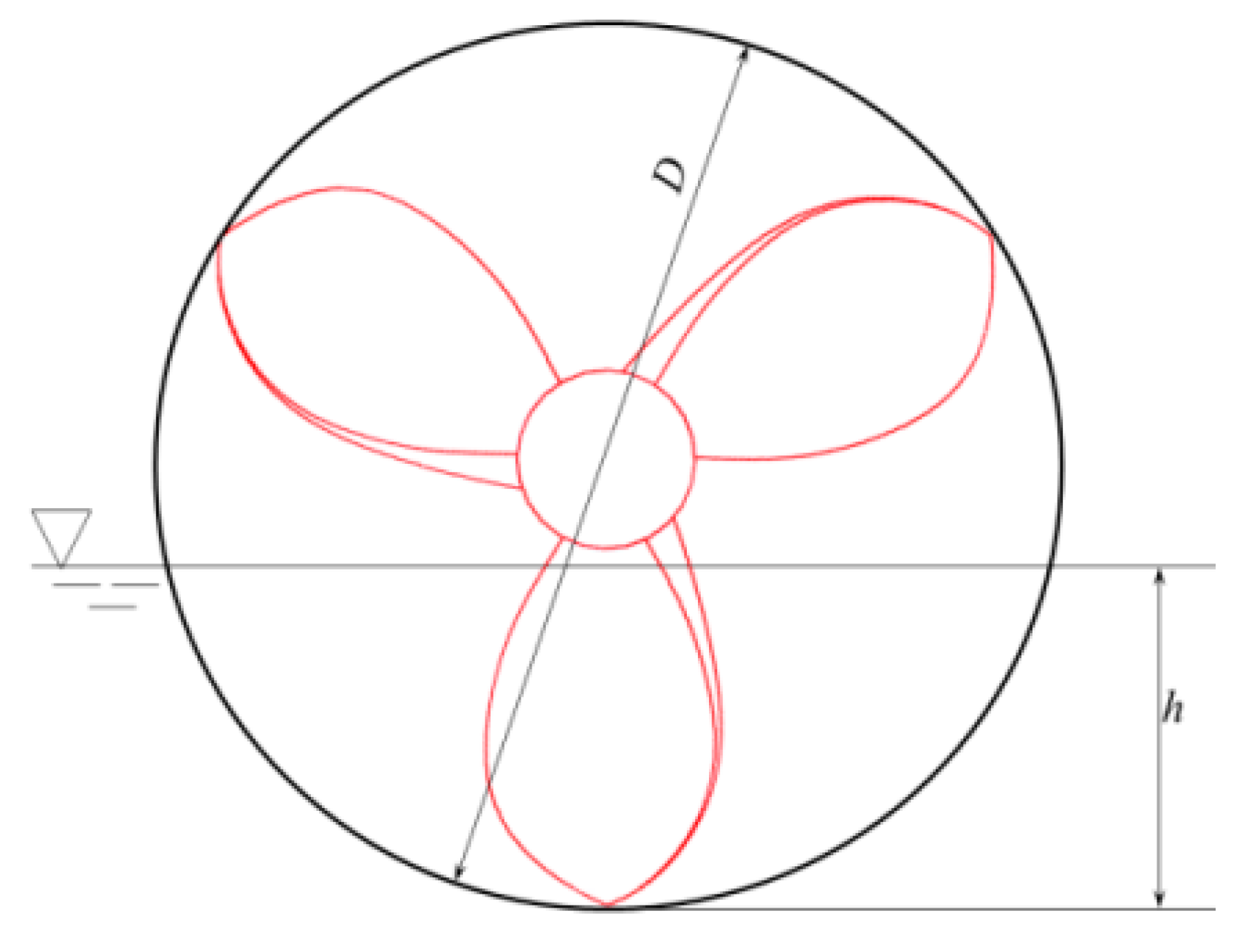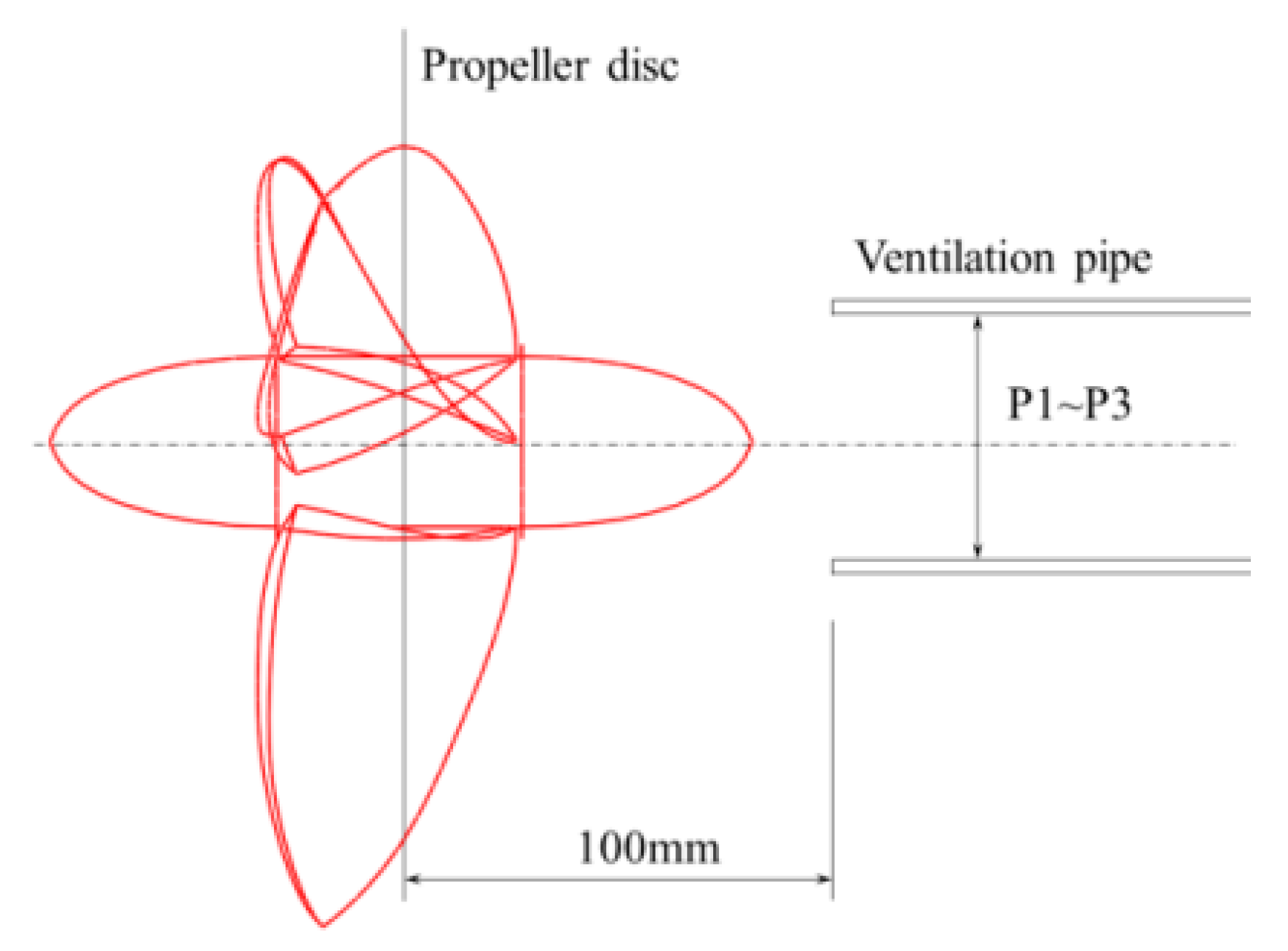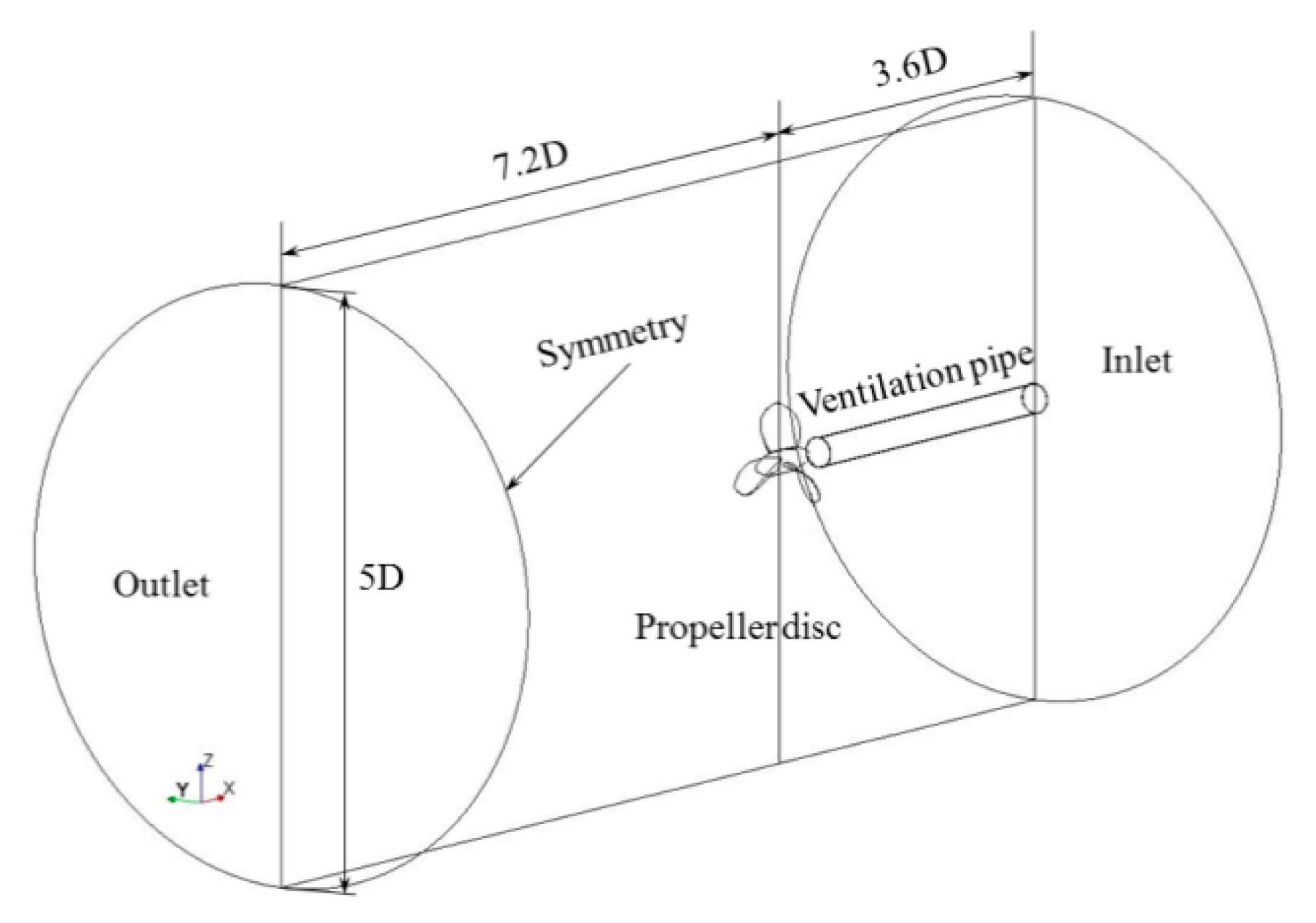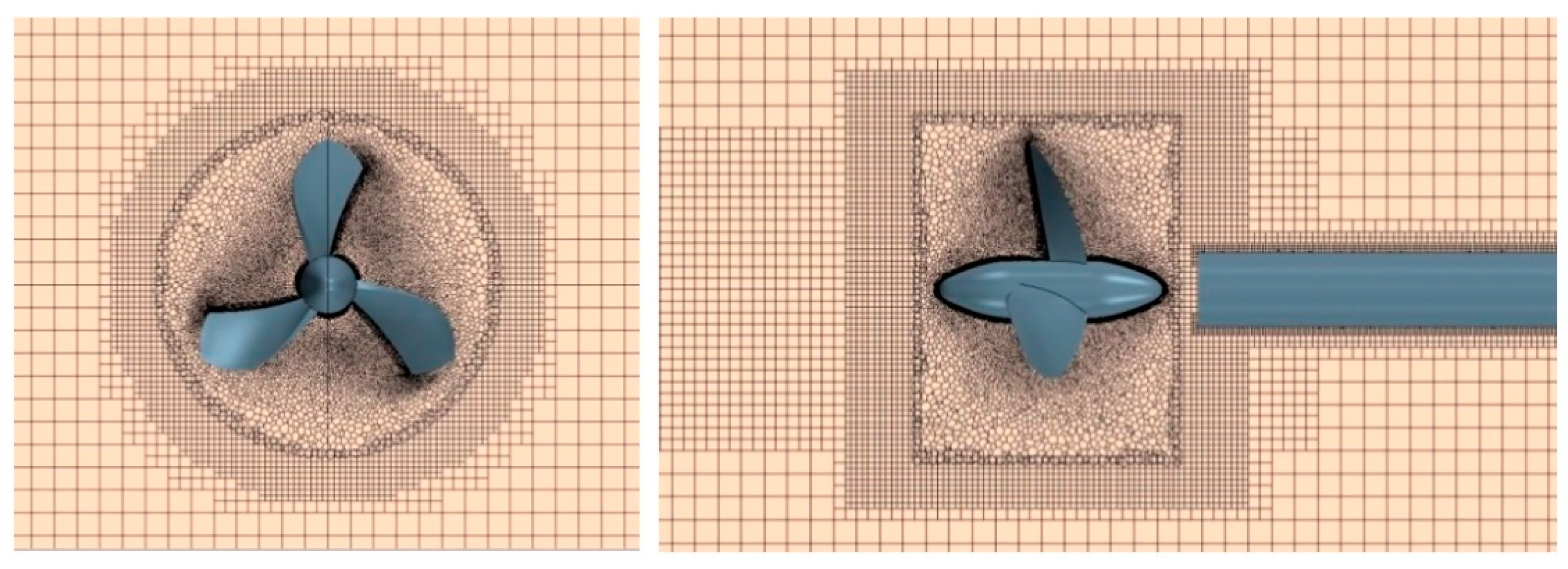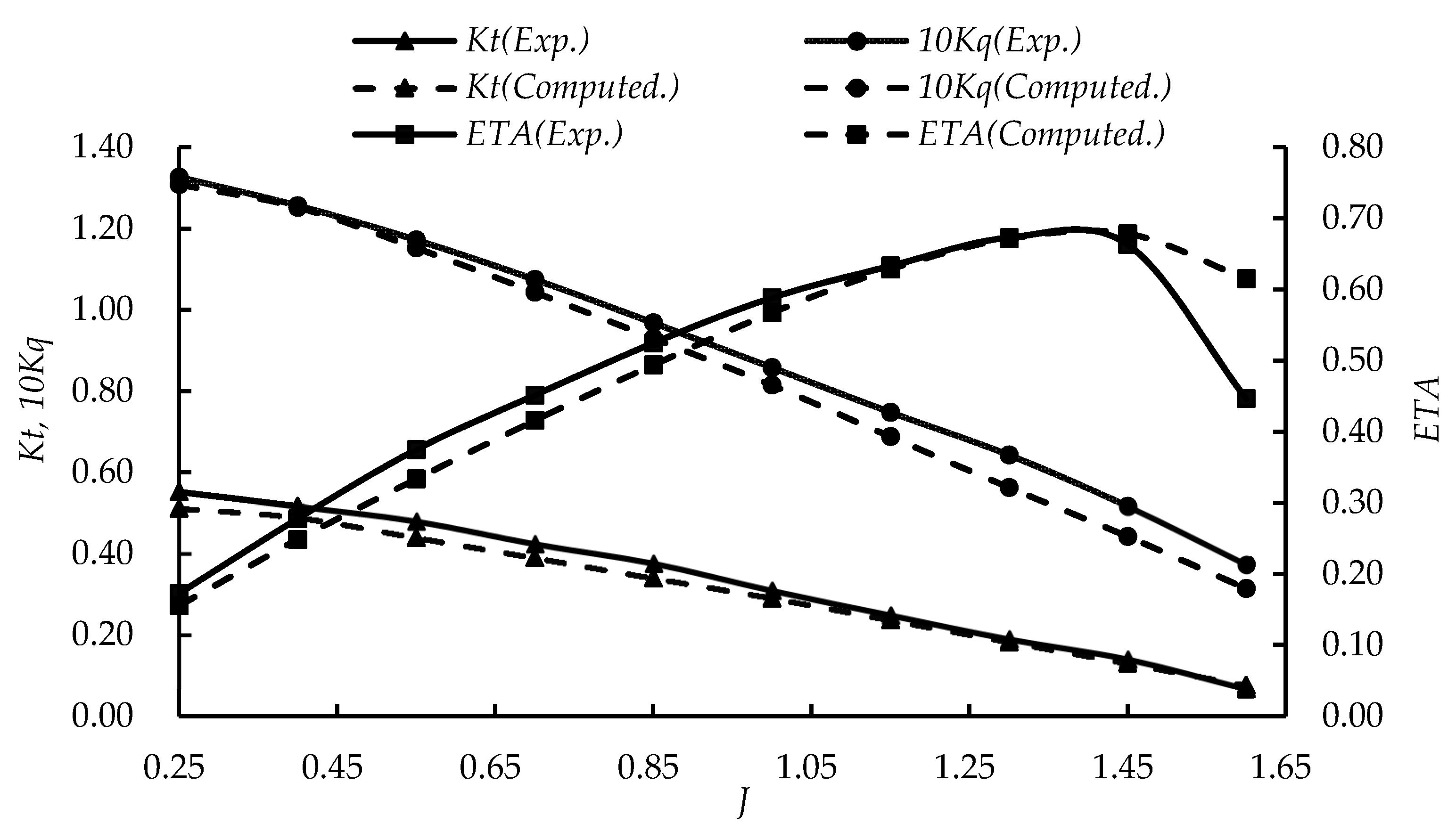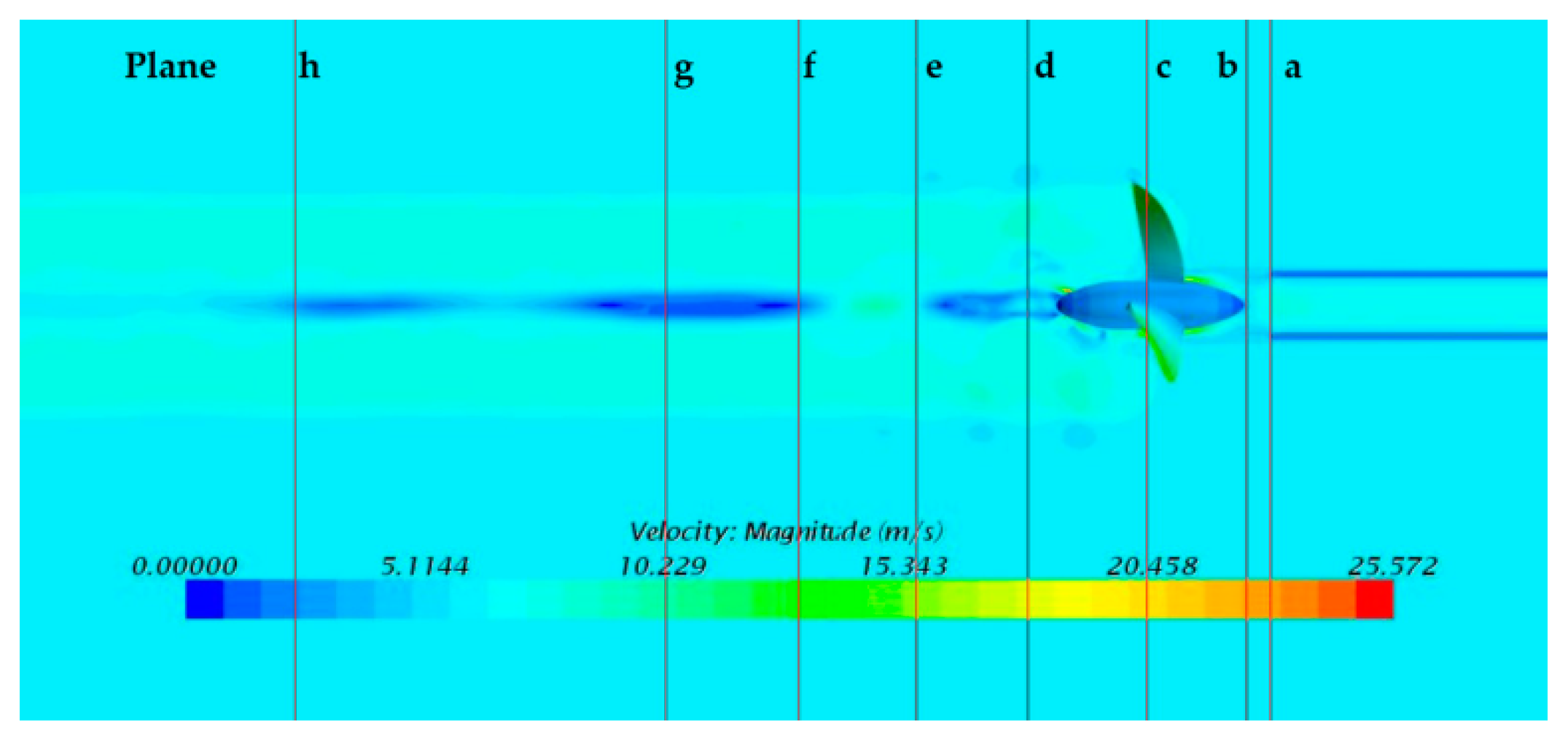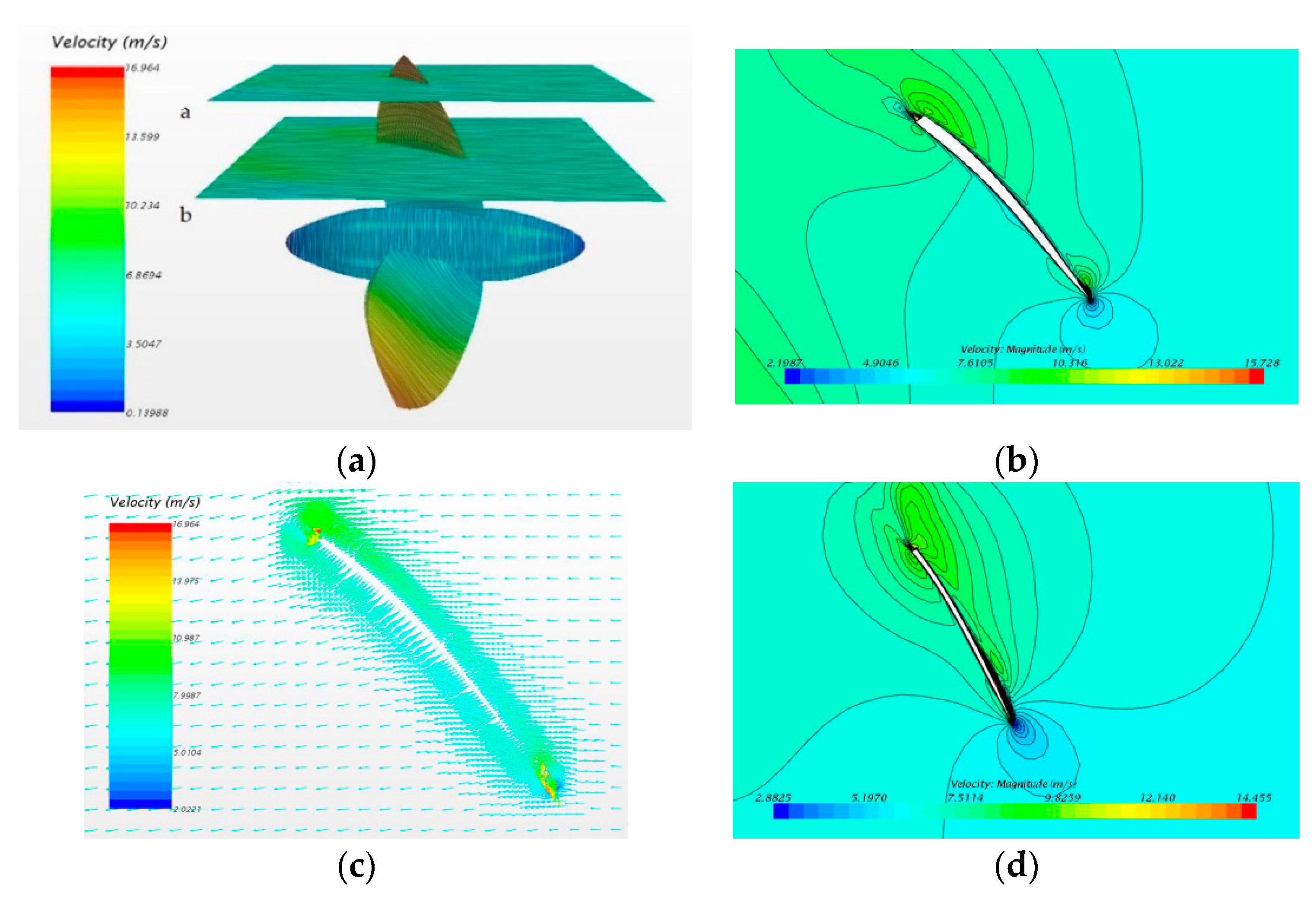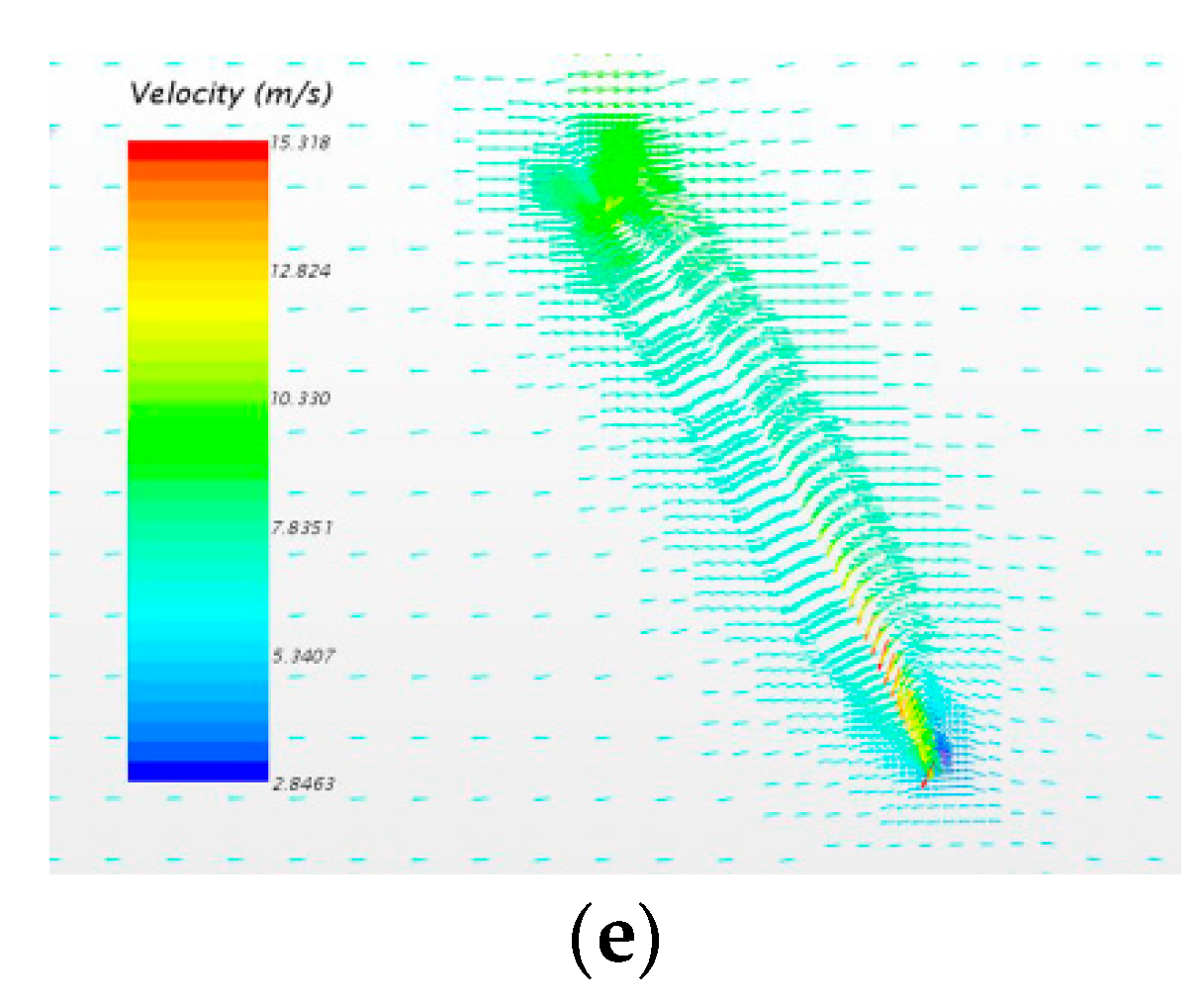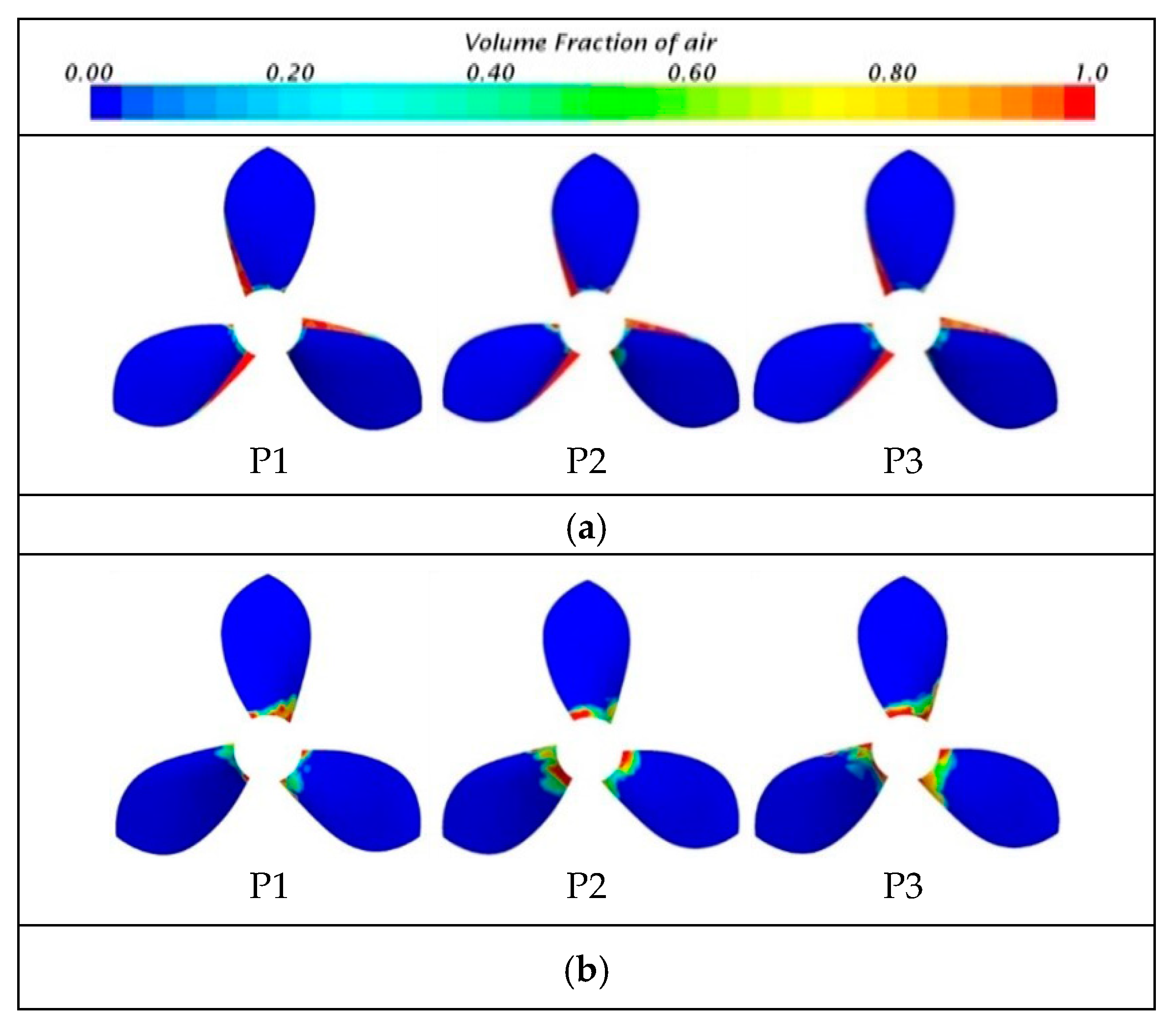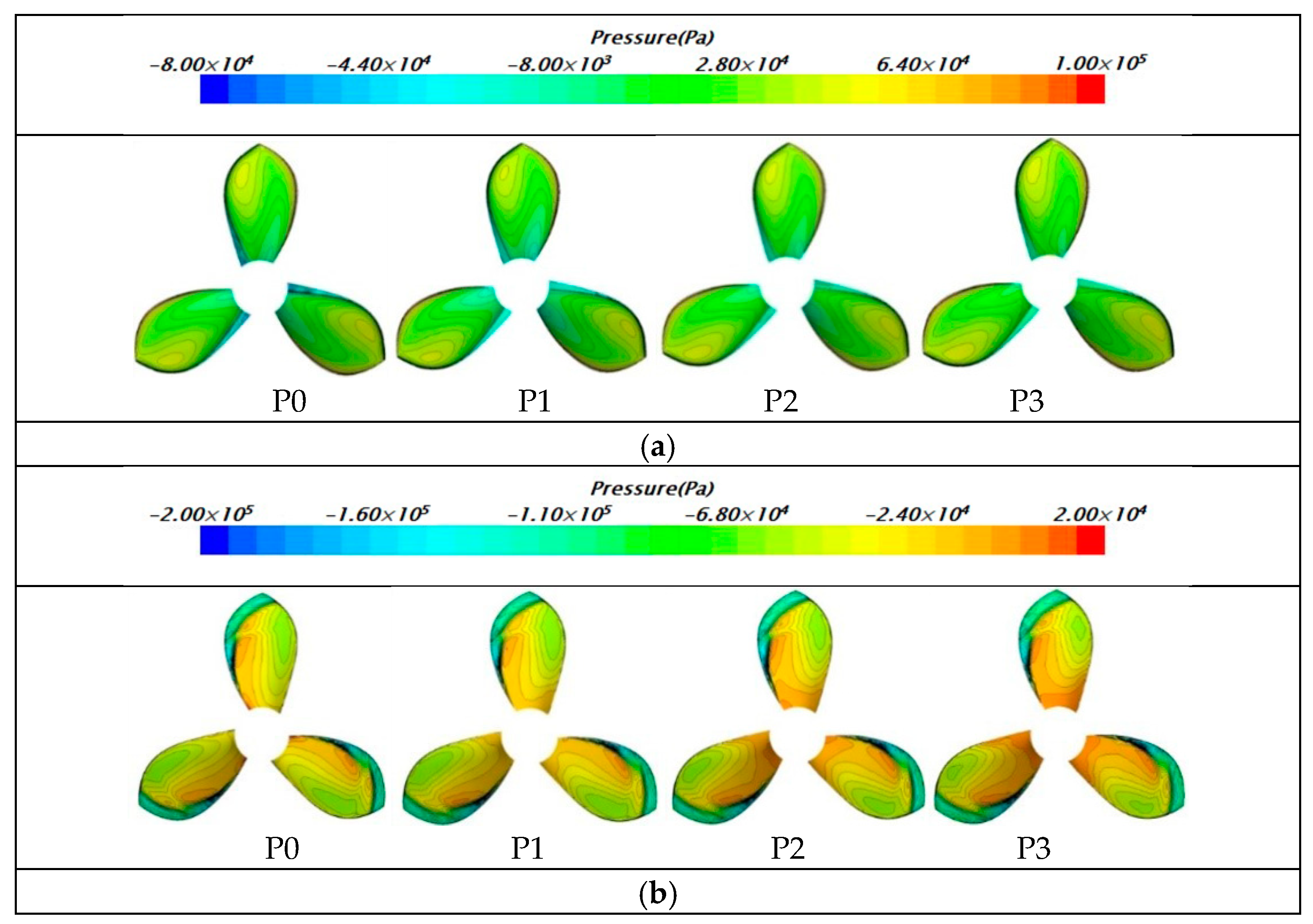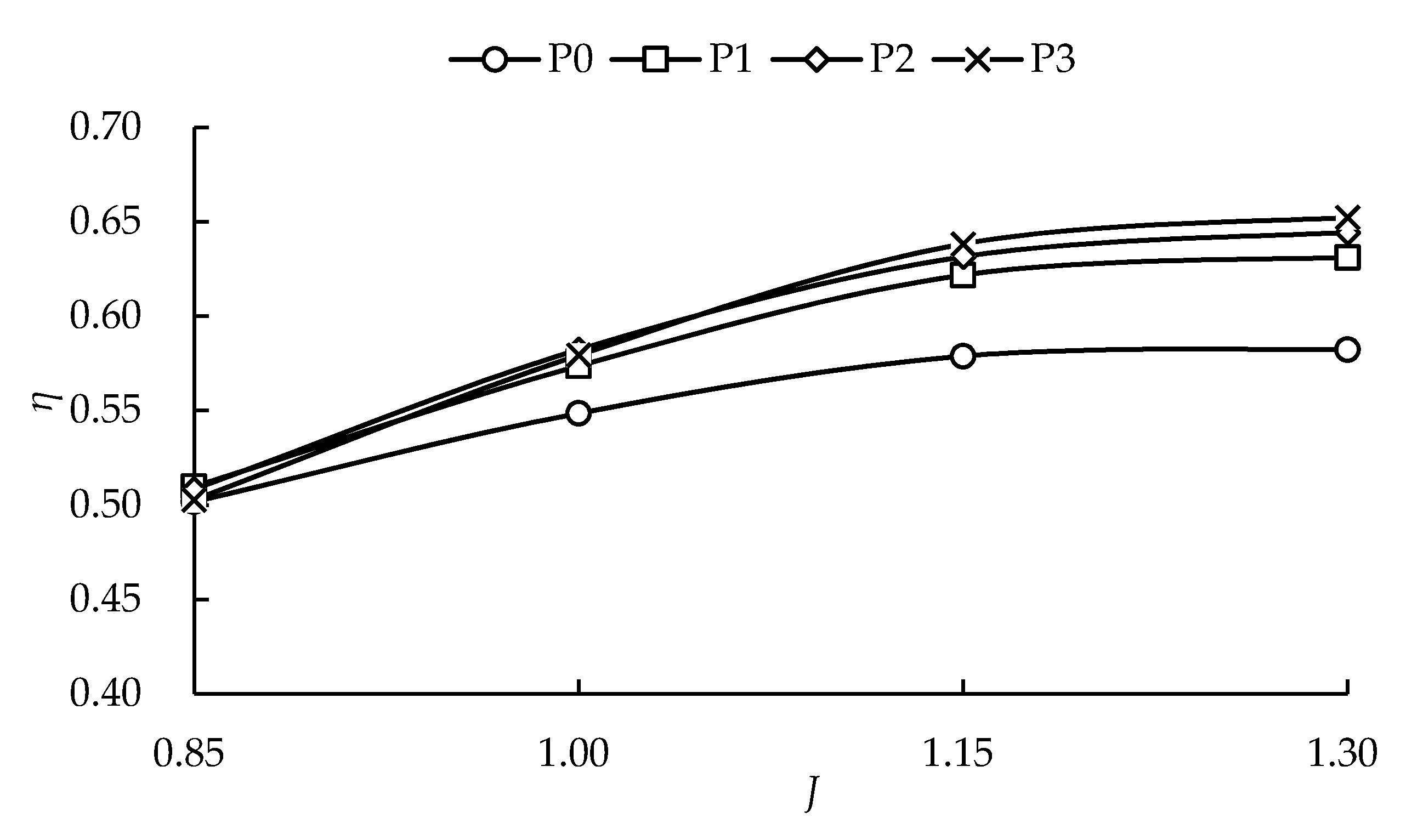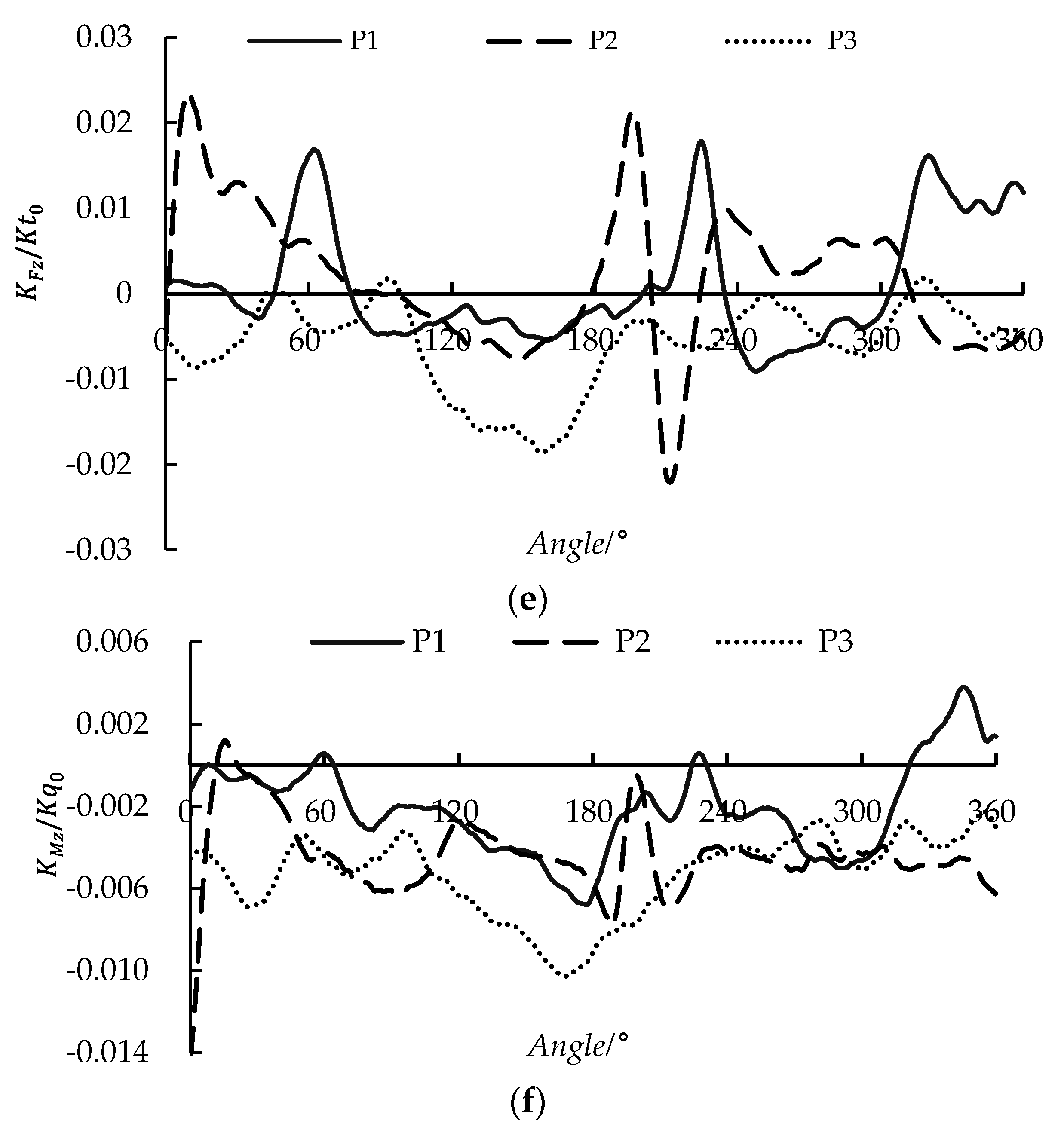1. Introduction
Surface-piercing propellers (SPPs) are defined as a propeller that normally operates with some parts of blades above water and the remaining parts are submerged in water. It is also known as the surface penetrating propeller. A summary of the advantages for the high performance of the surface-piercing propeller relative to conventional installations follows [
1]. (1) Propeller efficiency: surface-piecing propeller frees the designers form the limitations by the size of the propeller that will be operated. It is able to use a much deeper reduction ratio, lightly-loaded, and a larger propeller; (2) Cavitation: a surface-piercing propeller effectively eliminates cavitation by ventilation. With each stroke, the propeller blades bring bubbles into what would have been a vacuum cavity region. The erosion on the blades are obviously reduced; (3) Appendage drag: the surface-piercing propeller effectively eliminates drag from exposed shafts, struts and propeller hubs because the only surfaces in contact with water are the propeller blades and a rudder. Considering these advantages, the surface-piercing propeller is an attractive choice for high speed planning crafts. Therefore, it has really good research and application value.
Under the condition of large water immersion, surface-piercing propellers are inclined to be heavy loaded. The feasible way to solve this problem is equipping a vent pipe in front of a propeller disc to artificially ventilate the blades. It has been proved that this approach has been adopted in some practical crafts and achieved remarkable results. There are several research papers on the hydrodynamic performance of a surface-piercing propeller by Ghassemi et al. [
2], and only one research paper paid attention to the artificial ventilated SPPs by Yang et al. [
3]. In this paper, it focuses on the influence of the vent pipe diameter on hydrodynamic performance of the surface-piercing propeller by numerical methods.
Presently, the practical approaches to research the conventional propeller mainly rely on hydrodynamic experiments, theoretical research and Computational Fluid Dynamic (CFD) technology. The early studies forced on the load of whole SPP and single part. Olofsson et al. [
4] carried out several model tests and measured the loads and torques of single blade. It found that the Cavitation number and Froude number had a role in the hydrodynamic performance of SPP. It studied the flow around the blades in several immersion ratios (
I = 33%, 50%, 75% and 100%) and maneuvering condition (incident angles from 0° to 20°). Dyson et al. [
5] did a series of experiments on SPPs and obtained the thrust and torque values. It proved that the mean side and vertical forces account for about 20% and 40% of thrust, respectively. Peterson at el. [
6] analyzed the efficiency improvement on the surface piercing propellers using a full scale propeller. Through the preliminary calculation, it is proved that, when the fluid is moving along the axis, the propulsive efficiency is increased by about 3–5% compared to the case with an angle of attack at the same speed.
Researchers pay attention to theoretical research instead of model experiments on the study of submerged propellers. Hydrodynamic experiments are still the best way to estimate the hydrodynamic performance of the SPP. Although the valuable results of model experiments have been proved, it is a great investment in the money and time during the process of experiments. The accuracy and time cost of the calculation are also necessary to be considered. Therefore, the development of reliable, efficiency and general computational tools to predict the hydrodynamic performance of propellers is important for the design and application of the surface-piercing propellers. Zhao et al. [
7] investigated the hydrodynamic characteristics of the sprays results from the wedges moving into water with different inclination angles. A nonlinear boundary element method was proposed to analyze the load on the wedges. It demonstrated that a greater slamming pressure appeared on the wedges with increasing the wetted region. Once the inclination angle exceeds 30 degrees, the concentrated slamming stress on the wedges is not significant due to the small wetted region. Yari et al. [
8] continued Zhao’s research studied on the wedges. It measured the pressure distribution of a wedge entering the water by a 2D cross-section profile numerical method. It proved that the cup shape of trailing edge can strengthen the load on the edge and raise efficiency of SPP. Ghassemi et al. [
2] researched the hydrodynamic performance of SPP-1 and SPP-2 in the full and half immersion water with the boundary element method (BEM), compared with a series of experiments. It investigated that the Weber number plays an important role in the SPP under the ventilation condition. Furuya et al. [
9] primitively carried out a lifting line method to calculate the partially surface-piercing propeller. It used linearized boundary conditions to predict free surface effects. The thrust and torque coefficients of blades were calculated by the 2D water entry-and-exit theory by Yari et al. [
8]. However, the 2D approach limited in analyzing 3D problems leads to significant discrepancies with thrust and torque coefficients. Thus, a 3D approach to solve the fully ventilated foils entering into open water was proposed by Wang et al. [
10,
11,
12,
13]. The hydrodynamic performance of a fully ventilated surface-piercing propeller with the shaft above the water surface was predicted successfully by an unsteady lifting approach.
With the increasing requirement of researchers on computation technology, the CFD method becomes the most appropriate way to settle the surface-piercing propeller problem. Young et al. [
14,
15,
16] conducted a series of research papers on large-scale fully submerged propellers by a coupled boundary element method-finite element method (BEM-FEM). The BEM only predicted unsteady partial cavitation on conventional fully submerged propellers, while the BEM-FEM predicted surface-piercing propellers combined with a 3D boundary element method. Broglia et al. [
17] analyzed submerged propellers effects on maneuvering motion by the URANS method. Caponetto et al. [
18] measured the pressure on the blades by a RANSE solver. Himei et al. [
19] utilized RANS simulation and the Volume of Fluid (VOF) method to investigate the different advance ratios effects. It found that the numerical and experimental results maintained a high degree of consistency. Alimirzazadeh et al. [
20] used OpenFOAM software (4.0 version, OpenCFD Ltd., Bracknell, Berkshire, England) to verify the SPP-841B surface paddle performance under the different sway angles and depths conditions. It proved that the thrust and torque coefficient reduced with the increasing yaw angle.
Above all, researchers forced on the hydrodynamic performance of the surface-piercing propeller without a vent pipe in the past work. Yang et al. [
3] and Yuan et al. [
21] proved some feasible information with referencing values for artificial ventilated SPPs. Yang et al. [
3] simulated the surface piercing propeller with artificial ventilated pipe in front of the propeller disc. It proved that the SPPs with vent pipes were more efficient than that without a pipe under the fully immersed condition. Yuan et al. [
21] studied the hydrodynamic performance of 841-B propeller with an S-shape vent pipe. It demonstrated that the propeller enters the work section more conveniently with the ventilation increasing. With the blades rotating, the air column from the vent pipe was cut into pieces. Because the blade root did not contact with the air column, the propulsion of the propeller had a negative effect. With the increasing of the ventilated pipe diameter, thrust coefficient and torque coefficient decreased apparently. Hence, a surface-piercing propeller with an artificial ventilation is an attractive subject to demonstrate the difference between the conventional SPPs. In this paper, an Finite Volume Method (FVM) numerical simulation method of the three-blade paddle by equipping a vent pipe in front of the propeller disc was performed based on the Star-CCM+ software (9.06 version, Group: Melville, New York, USA) [
22]. The right-handed SPP was calculated to validate the forecast accuracy compared with experimental data. The rotation region of SPP was set to the overlapped mesh. The ventilation pipes with different diameters were installed in front of the propeller disc.
2. Geometry and Numerical Procedure
2.1. Nondimensional Parameters
Through the dimensional analysis of the control fluid dynamics equation originally established by Shiba et al. [
23], it was demonstrated that there are five foundational non-dimensional parameters of the ventilation pipe as: immersion ratio (
), Reynold number (
), Froude number (
) and Weber number (
). These parameters equations are defined as follows:
Weber number:
where
,
,
,
,
, and
. are basic parameters of SPP. They are defined as immersion of propeller, diameter of propeller, revolution rate of propeller, kinematic viscosity of water, gravitational constant and capillarity constant of water, respectively. The immersion of propeller is defined as the ratio of the distance between free surface and propeller blade tip to propeller diameter, as shown in
Figure 1.
In general, the surface-piercing propeller is positioned in which the waterline passes right through the propeller hub when the craft is sailing under normal conditions, which means that each blade is out of water in half the time of each propeller rotation. While one blade is revolving one circle around, the propeller blade brings the air bubble into the vacuum cavity region, generating an air cavity. One side of the cavity is connected to the atmosphere and the other to the blade. The water shock effect on the blade is suppressed, when the air entrained in the cavity compresses with the air cavity compressed. In fact, it is proved that propeller operating in the cavitation situation is more efficient than that under the immersed condition. Due to the influence of the attitude changes of the craft body, it is impossible to ensure that SPP is right in the position of ventilation state. Once the propeller is fully immersed in the water, the torque increases sharply. An approach that equipped an artificial air vent pipe in front of the propeller can accomplish the purpose of reducing torque. Meanwhile, it is also possible to reduce torque by changing pipe diameters.
2.2. Geometry
In the numerical calculation, the target propeller model is an SPP-1 surface-piercing propeller. The rotation direction is right-handed. The basic parameters of the SPP-1 surface-piercing propeller are shown in
Table 1.
The geometry of the propeller and the vent pipe is shown in
Figure 2. The distance from the outlet of vent pipe to the front of propeller is 100 mm, and the chosen ventilation pipe diameter are P1 (30 mm), P2 (40 mm), and P3 (50 mm), respectively. For comparison, there is a P0 case that represents SPP-1 operating under the full immersion condition without ventilation.
2.3. Governing Equations
The governing equation for the conservation of mass can be written as Equation (5):
where
. is the water density,
is the velocity component in each direction, and
. is the time.
is the added mass attached to continuity term, which is defined as zero in some cases.
The governing equation for the momentum conservation can be written as Equation (6):
where
. is the gravitational acceleration,
is the body forces,
is the dynamic viscosity, and
is the Reynolds stress tensor.
where
is the Kronecker delta.
Considering the equations above, the Reynolds averaged momentum equation is defined as Equation (8):
It is significantly noticed that the term is associated with the turbulence flow. Thus, a relevant turbulence model approach should be proposed.
In this paper, the
based Shear Stress Transport (SST) model is required for the propeller turbulence calculation. The
SST model is deduced by Menter at el. [
24]. It is a blending function that is coupled with the
and
models. The SST model applies the
model which has good performance to calculate far field, while using the
. model to solve the near wall region problems. These approaches are based on the RANS turbulence model for monitoring the hydrodynamic performance of flow.
2.4. Free Surface Modeling
The vent pipe keeps the propeller in the air-water two phase flow region under the fully immersed condition. For the interface of water and air, the volume of fluid (VOF) model is adopted, whose basic principle is to determine the free surface by capturing the fluid and mesh volume ratio function in the grid. Otherwise, air and water are considered as incompressible fluids:
, volume completely filled with reference phase,
, volume completely not filled with reference phase,
, volume partially filled with reference phase.
Due to the individual identity of each fluid particle, the material derivative should be zero with the communication in the volume fraction
:
Once the volume fraction is determined, the real density and viscosity calculated in each grid can be obtained as Equation (10):
2.5. Hydrodynamic Parameters
While predicting the hydrodynamic performance of the SPP, a series of momentous parameters should be calculated as follows:
Advance speed coefficient:
Promote efficiency:
where
,
,
,
, and
are the forward speed of propeller, revolution rate of propeller, thrust coefficient, torque coefficient and efficiency, respectively.
2.6. Grid Generation and Boundary Conditions
For the accurate numerical simulation, the region is generated pertinently to monitoring the fully developed flow flowing through the propeller. The computational domain is divided into two parts. They are the external cylindrical stationary region and the interior cylindrical rotating region with the propeller inside. The computational domain and boundary conditions are shown in
Figure 3. The diameter of external stationary region and interior rotating region is 5.0D and 1.2D, respectively. The distance between the velocity inlet and propeller plane is 3.6D, while that between the pressure outlet and plane is 7.2D. For the rotating region, the two sides of cylindrical surfaces are 0.45D to the propeller surface.
Due to the stationary region and rotating region having a relative motion during the propeller revolution, the overlapping mesh method was chosen to approach the effectiveness of information exchange. The mesh size of overlapping grid connected with two regions should be the same as much as possible. The quadrangular structured mesh was employed in the stationary region, which satisfies the developed flow after the propeller, while the polyhedral mesh was generated in the rotating region for flowing around the propeller. For checking the mesh independency, there are several cases of meshing that were simulated that are expounded in the following section: the cross-section views of volume mesh are shown in
Figure 4.
2.7. Mesh Independency and Grid Convergence
Considering the accuracy of the unstructured mesh near the propeller surface, the term
Y+ is proposed for judging the grid near the wall. The
Y+ value is defined as Equation (16):
where
is the velocity at the nearest wall,
is the distance to the nearest wall, and
is the fluid kinematic viscosity. The
Y+ value on the blade surface should be between 30 and 300. The growth factor of the distances adjacent to two grids should be 1.10. Thus, the first boundary layer grid distance on the blade is calculated as following Equation (17):
where
is the first grid distance, and
is the characteristic length.
In this study, a series of meshing generated for several
Y+ values are demonstrated in
Table 2. The calculated parameters, thrust coefficient
and torque coefficient
, impairing propulsion efficiency are compared with the experiment results by Ghassemi et al. [
2]. Ghassemi et al. [
2] carried out experiments on three bladed propellers (SPP-1) in the immersed condition. The thrust coefficient (
) and torque coefficient (
) are 0.3093 and 0.8579 as shown in
Table 2.
Table 3 illustrates the numerical simulated results of thrust (
) and torque coefficient (
) for five
Y+ cases. In addition, it shows the error of experiment data and simulation data. It is clearly obtained that the error of thrust and torque coefficient are both satisfied in the minimum position when the
Y+ is 60. Whether it goes up or down, the accuracy of simulation is decreasing. Thus, it concluded that
Y+ is equal to 60 which is the ideal choice to guarantee calculation precision. These data are calculated at
.
It should be considered that the investigation of the numerical grid convergence plays an important role before diving into further research. The numerical simulation was carried out with four different grid numbers. It demonstrated that the simulation results are closer to the experiment data with the increasing of volume grid. Thus, the grid schedule of G4 case is a good choice. However, it is not an excellent choice that a large amount of computing time sacrificed for a tiny accuracy improved. Therefore, the fine mesh G3 is the available scheme that is simultaneously satisfied to the efficiency and accuracy.
In order to validate the prediction accuracy of the numerical calculation method for the ventilation phenomenon and the air–water interface, the SPP-1 was selected for studying under the condition of full immersion. The advanced rotational speed
n is 2400 rpm. There were five different speed coefficients selected from 0.85 to 1.60, which was calculated by Equation (12). In this paper, hydrodynamic results obtained by simulating the surface-piercing under the full immersion condition, which are thrust coefficient, torque coefficient and the open water efficiency, are compared with the existing experimental results by Ghassemi et al. [
2].
As shown in
Figure 5, the thrust coefficient
and the torque coefficient
measured by the CFD method are slightly larger than the experimental ones at a low advanced speed. Conversely, the calculated efficiency
result is slightly smaller than the tests. The results show an accordant tendency for a little receivable error. Considering the complicated flow field, it can be seen that the numerical results agree well with the experimental data. This research demonstrates that the CFD approach can meet the demand for the surface-piercing propeller hydrodynamic prediction.
2.8. Initial Conditions
On the basis of a ventilation phenomenon under the full immersion condition, the liquid around the propeller is flowing in the form of unsteady two-phase flow. The density of water and air is 997.56 kg/m
3 and 1.18 kg/m
3, respectively. The dynamic viscosity of water and air is 8.89 × 10
−4 Pa-s and 1.86 × 10
−5 Pa-s, respectively. In this paper, due to a function of the artificial vent pipe installation, the velocity inlet was classified as air velocity inlet and water velocity inlet, whose velocities are exactly the same. The volume fraction of each velocity inlet was set to 1 and 0 for volume fraction of water and air, respectively. The pressure outlet was set as reference pressure at the end of the cylindrical stationary region. The other side of the stationary region was set as symmetry. The interface of the SPP blade and vent pipe were set as a non-slip wall. The solution being set up with physical model in Star-CCM+ was summarized in
Table 4.
The second-order schemes were employed for implicit unsteady discretization, linear interpolation, and time integration. The time step is defined as 1.5 × 10−4 s, which satisfies the condition of CFL 1, when the propeller rotates for one degree. The numerical calculation was simulated on a PC with an Intel Xeon CPU X5690 (six cores, 3.46 GHz) (Santa Clara, CA, USA). It cost 60 h for one case simulation.
